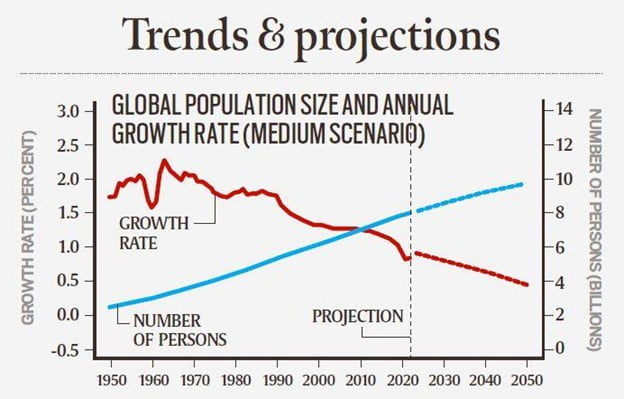Economics
In News: World Population Prospects 2022 was released UN Dept of Economic & Social Affairs
World Population Prospects
- The Population Division of the UN has been publishing the WPP in a biennial cycle since 1951.
- Each revision of the WPP provides a historical time series of population indicators starting in 1950.
- It does so by taking into account newly released national data to revise estimates of past trends in fertility, mortality or international migration.
Takeaways for the global population
- Currently, with 7 billion Asia is the most populous continent and has 61 per cent of the global population, 17 per cent reside in Africa (1.3 billion), 10 per cent in Europe (750 million), 8 per cent in Latin America and the Caribbean (650 million), and the remaining 5 per cent in Northern America (370 million) and Oceania (43 million).
- The world’s population continues to grow, but the pace of growth is slowing down: The global population is expected to grow to around 8.5 billion in 2030, 7 billion in 2050 and 10.4 billion in 2100.
- In 2020, the global growth rate fell under 1% per year for the first time since 1950.
- Rates of population growth vary significantly across countries and regions: More than half of the projected increase in global population up to 2050 will be concentrated in just eight countries: the Democratic Republic of the Congo, Egypt, Ethiopia, India, Nigeria, Pakistan, the Philippines and the United Republic of Tanzania.
- The 46 least developed countries (LDCs) are among the world’s fastest-growing.
- Many are projected to double in population between 2022 and 2050, putting additional pressure on resources and posing challenges to the achievement of the UN’s Sustainable Development Goals (SDGs).

- A sustained drop in fertility has led to an increased concentration of the population at working ages (between 25 and 64 years), creating an opportunity for accelerated economic growth per capita.
- International migration is having important impacts on population trends for some countries:
- For high-income countries between 2000 and 2020, the contribution of international migration to population growth (net inflow of 80.5 million) exceeded the balance of births over deaths (66.2 million).
- Over the next few decades, migration will be the sole driver of population growth in high-income country

India specific findings
- India is expected to surpass China as the world’s most populous country in 2023.
- Presently 417 billion, India’s population is expected to rise to 1.429 billion to surpass China.
- The concern now is not about the absolute numbers — India’s population is already 1.4 billion and may go up to 1.6 billion before declining — but the quality of life for the people alive.
- The focus now has shifted to whether we can reduce poverty, provide healthcare facilities, education
- From data it is clear that cohorts of 0-14 years and 15-24 years will continue to decline while those of 25-64 and 65+ will continue to rise for the coming decades.
Policy implications arising out of these two trends
For those already in the 25-64 age bracket
- Skilling is the only way to ensure they are more productive and have better incomes.
The 65+ category
- Provisioning of social security is obviously a big challenge. This will stretch the resources of the future governments.
- In this context, aged stay within the family set-up, reduces the burden on the government.
Source: Indian Express
Previous Year Question
Q.1) The Global Competitiveness Report is published by the (2019)
- International Monetary Fund
- United Nations Conference on Trade and Development
- World Economic Forum
- World Bank














